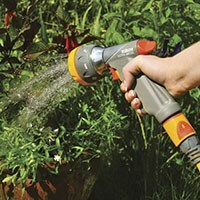Water-saving ideas
Alan Titchmarsh explains how to take the hard work out of watering your garden this summer
Tools for the job
 One of the biggest challenges in the summer garden is keeping up with the watering. If, like me, you have a lot of containers, a greenhouse or like to raise your own fruit and vegetables, efficient and effective watering is essential. I like watering, and find the time spent on watering duty a useful way of monitoring progress in the garden. However, I’m always on the look-out for techniques and methods that will make life easier. Targeting the water on plants and stages of growth that need it the most, means that I will save money on water and ensure good yields, too.
One of the biggest challenges in the summer garden is keeping up with the watering. If, like me, you have a lot of containers, a greenhouse or like to raise your own fruit and vegetables, efficient and effective watering is essential. I like watering, and find the time spent on watering duty a useful way of monitoring progress in the garden. However, I’m always on the look-out for techniques and methods that will make life easier. Targeting the water on plants and stages of growth that need it the most, means that I will save money on water and ensure good yields, too.
Essential equipment
- Long-spouted watering can
- Self-reeling hose
- Hose lance
- Soaker hose
- Drip system
- Water timer
- Self-watering spikes
- Sprinkler
- Self-watering tray
In a small garden, you may be able to cope with the demands of watering using only a watering can. Make sure it is comfortable and well-balanced when full, as well as when pouring. Long-spouted watering cans are particularly useful for watering containers and deep borders full of new plants, because the jet of water is easier to aim accurately - so watering is more efficient. Once you have more than a dozen pots, then it becomes laborious and time-consuming refilling the watering can. The answer is a flexible and manoeuverable water transport system – the garden hose. A hosepipe is particularly useful if you have a long garden, or have pots and plants to water in the front garden too. Fixed to an outside tap a reinforced, kink-resistant hosepipe will make watering a whole lot easier. Bear in mind that once full of water the hosepipe is heavy and can cause damage to delicate plants when being dragged about the garden, so fit corner protectors to your flowerbeds. There are even rather attractive, beech bollard, hose guides now available that add a finishing touch to your borders. A wall-mounted, self-reeling hosepipe means you don’t have to handle a wet and unwieldy hosepipe after watering, although a hose-tidy, fitted next to the outside tap, will make storing a traditional hose neatly a lot easier, too. A hose trolley is another time-saving option.
A hosepipe provides a never-ending supply of water almost anywhere in the garden, but to apply that water accurately and efficiently you need to add a trigger-operated spraygun on the end. For hanging baskets and deep beds choose a long-handled hose lance that will give you extra reach and accuracy. You can now get flexible lances that can be manipulated into exactly the right shape to water at every conceivable angle.
Watering gets even more challenging in the greenhouse and where you grow your own fruit and vegetables. A different tactic is needed to keep on top of the demand. In the vegetable plot and fruit garden you can use soaker-hose to gently trickle the water along rows of crops and over the root area of permanent fruit trees and bushes. They work best when buried just below the surface or can be covered by a layer of mulch. You can either link a hose to the end of the soaker pipe at watering time and leave it to seep unattended, or plumb the soaker hoses into a connector and water timer to make the whole process completely automatic. In the greenhouse, container plants can be stood on capillary matting, so that they can draw up the moisture they need at all times. Growing bags and border crops are irrigated automatically using a drip-feed system. All you need to do it top up the reservoirs from time to time.
 Drought-resistant plants Once established, most permanent border plants require a lot less watering than temporary plants, such as bedding. However, in dry spots in the garden and containers, it’s a good idea to choose drought-resistant plants to help reduce the need for watering during prolonged dry spells. Select plants to suit the conditions you have, such as drought-tolerant, sun-loving plants for a sunny, well-drained border at the base of a wall or in a container on a sunny patio…or drought-tolerant, shade-loving plants for a dry, shady spot - often found under a tree or at the base of a hedge. If you are creating a new garden from scratch or planting a new border, these ready-made borders might give you some ideas.
Drought-resistant plants Once established, most permanent border plants require a lot less watering than temporary plants, such as bedding. However, in dry spots in the garden and containers, it’s a good idea to choose drought-resistant plants to help reduce the need for watering during prolonged dry spells. Select plants to suit the conditions you have, such as drought-tolerant, sun-loving plants for a sunny, well-drained border at the base of a wall or in a container on a sunny patio…or drought-tolerant, shade-loving plants for a dry, shady spot - often found under a tree or at the base of a hedge. If you are creating a new garden from scratch or planting a new border, these ready-made borders might give you some ideas.
Shimmering evergreen grasses and grey, architectural plants contrast brilliantly with flowers of yellow, blue and purple. The Mexican Fleabane (Erigeron) exhibits daisy flowers virtually all summer. Don't worry, you don't have to cover your border with gravel. All this bed requires is a sunny, sheltered spot and an open, free-draining soil. The Mexican Daisy (Erigeron), the grasses and the spurge (Euphorbia) is likely to self-seed in a gravel path or between paving slabs. This design will fit into a border 3.5m long by 1.75m wide.
- Kniphofia 'Little Maid'
- Erigeron karvinskianus
- Agapanthus africanus
- Sedum (Herbstfreude Group) 'Herbstfreude'
- Helictotrichon sempervirens
- Euphorbia palustris
- Campanula lactiflora 'Pritchard's Variety'
- Phormium 'Maori Sunrise'
- Eryngium giganteum 'Silver Ghost'
- Agapanthus Headbourne hybrids
- Anthemis tinctoria 'E.C. Buxton'
- Stipa tenuissima
- Convolvulus cneorum
Turn a partially shady corner into an eye-catching feature with this pink combination based around a superb star magnolia. This border has been designed so you will have a procession of colour throughout the warmer months of the year. The magnolia will be the first plant into flower in spring and produces wonderful spidery blooms in the palest of pinks. The fronds of the Dryopteris will make an attractive feature as they unfurl and will be followed by a number of pink-flowering plants through the summer and into the autumn. You will need a 1.5 x 1.5m corner bed.
- Astrantia major 'Rubra'
- Anemone hupehensis 'Hadspen Abundance'
- Astrantia 'Roma'
- Magnolia × loebneri 'Leonard Messel'
- Thalictrum aquilegiifolium
- Dryopteris erythrosora
Sandy soils are incredibly easy to work with, however, they are usually very hungry and need copious amounts of water as the open texture means that all the water and nutrients easily drain away. The plants in this border will thrive in these conditions, but it is important to make sure they are kept well -watered until they have had a chance to become established. Apply a mulch of composted organic matter at least once a year, to help improve the soils fertility and water holding capacity.
- Euphorbia × martini
- Yucca filamentosa
- Salvia nemorosa 'Ostfriesland'
- Kniphofia 'Royal Standard'
- Geranium 'Johnson's Blue'
- Allium sphaerocephalon
- Lavandula pedunculata subsp. pedunculata
- Alcea rosea 'Nigra'
- Achillea filipendulina 'Cloth of Gold'
- Ceratostigma willmottianum Forest Blue
- Centranthus ruber
- Agapanthus Headbourne hybrids
- Echinops ritro 'Veitch's Blue'
- Artemisia ludoviciana 'Silver Queen'
- Cistus × argenteus 'Silver Pink'



